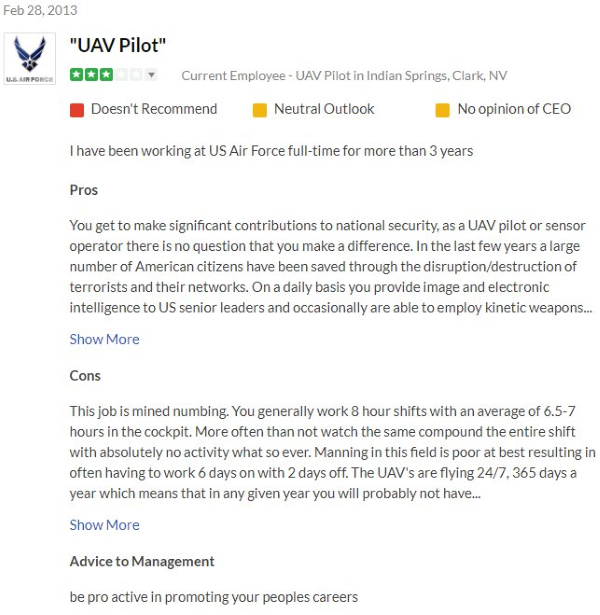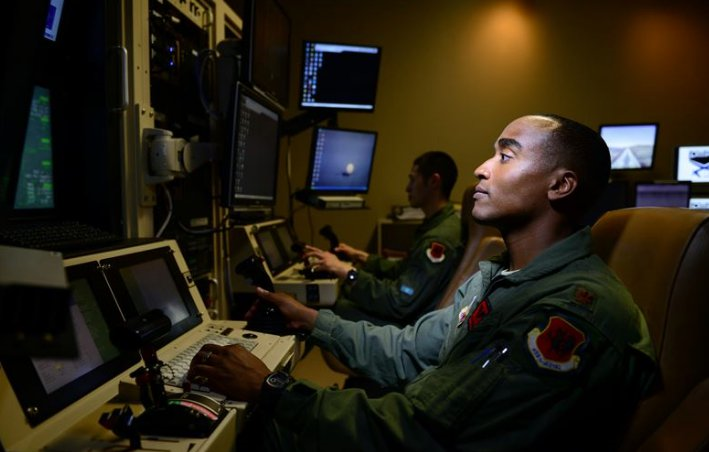If you were asked what type of aircraft do the largest number of US Air Force Pilots fly, what would you say?
Would it be the F-16, the ultra-modern F-22 or even the old but still immensely popular KC-135R Stratotanker?
The truth is, if you said any answer besides US Air Force Drone Pilots, you would be very wrong.
That’s what makes operating remotely piloted aircraft (RPA) such an in-demand job in today’s modern Air Force.
These mostly Air Force officer manned jobs are in such high demand that civilian contractors currently are being used to supplement the Air Force drone pilot workforce.
Related Article – Air Force Jobs List: A List Of All AFSC’s In The Air Force
That means that although this is an Air Force career choice that is demanding and somewhat stressful, it’s a highly important Air Force job that also offers a great opportunity for advancement.
RPA’s are here to stay both in the military and civilian world.
Anyone that trains for this type of Air Force career should never be without a well-paying job unless they choose to do so.
Jump To A Section
Training And Career Path
What’s Life Like as an Air Force Drone Pilot?
Pay And Benefits
Job Reviews
Civilian Career Opportunities
Requirements and Qualifications
Here are the requirements it takes to become eligible for training as an Air Force Drone Pilot:
- Start drone pilot training between the ages of 17 and 29
- Have normal color vision and depth perception
- Holding a Bachelor’s degree in the physical sciences, mathematics, business administration, or business management is preferred
- Completion of Officer Training School (OTS) or 4 years of undergraduate study at the Air Force Academy (AFA) or be a member of the Air Force Reserve Officer Training Corps (AFROTC) (Note: Because of drone pilot shortages throughout the Air Force, since 2015 a limited number of current Air Force enlisted personnel (Rank E-4 and above) who work on aircrews are being specially selected to cross-train into becoming pilots of unarmed RPA systems.)
- Must meet qualification guidelines for air vehicle operator duty according to AFI 48-123
- Completion of a current Single Scope Background Investigation (SSBI) that leads to the ability of the US Air Force Drone Pilot candidate to be granted access to Top Secret material
Training and Career Path
Here are the training requirements it takes to become fully certified to fly drones as part of an Air Force career.
This process normally takes well over a year to complete unless those entering it already have a civilian pilots license.
Air Force Technical Training Information
Initial Flight Training (IFT) Program: Remotely Piloted Aircraft Track
This 3-month long course has been run for many years now by a military subcontractor called L3Harris/Doss Aviation.
This is held at the company’s state-of-the-art training facility in Pueblo, Colorado.
It’s not only used as an introductory course for flying remotely piloted aircraft but it also serves as a screening process to determine someone’s suitability for further drone pilot training.
Related Article – Air Force Pararescue (PJ’s): Career Details
This course is designed to gauge a future drone pilot’s aptitude for flight and introduce them to the rigors of military drone aviation.
It covers such practical drone flight training as basic instrument flying, cross-country flying, solo cross country flying, and night flying.
URT (Undergraduate RPA Training)
This course takes place at Randolph AFB in Texas and lasts just under 4 months.
It greatly expands upon what was learned by drone pilot candidates in the IFT drone training course.
This course focuses heavily on drone flight characteristics and further instrument qualification.
Those who complete this phase of training will then receive their Air Force remotely piloted aircraft wings.
Formal Training Unit (FTU)
FTU training takes place over a 3-month period at Beale AFB, California for RQ-4 Global Hawk drone pilots and over a 4 ½ – month period at various locations (Creech AFB, Nevada; Holloman AFB, New Mexico; March ARB, California; and in Syracuse, New York) for MQ-9 Reaper drone pilots.
This program trains new Air Force RPA pilots to fly and operate the controls and sensor systems on the same drone aircraft that they will be tasked with piloting at their first duty station.
On the Job Training
After URT training is completed, there will be an extended period of on the job training for new drone pilots at their first duty assignment.
This training will further hone a new drone pilots flight skills as they prepare to be able to assume a regular turn as an independent drone aircraft operator.
Much of this on the job training will be mission-specific and related to the activities performed by the trainee’s newly assigned drone squadron.
More on the US Air Force Drone Training Program can be seen here on this YouTube video.
How Much Are Air Force Drone Pilots Paid?
All Air Force members, regardless of rank or status, will be paid by a combination of their rank and the total time they have spent serving their country in the military.
Most of the candidates entering into Air Force Drone Pilot training will be officers currently in the Company Grade ranks of Second Lieutenant (O1) or First Lieutenant (O2).
Here is the current paytable for officers in the US Air Force:
| Insignia | Pay Grade | Rank | Abbreviation | Minimum Monthly Pay |
|---|---|---|---|---|
| O-1 | Second Lieutenant | 2d Lt | $3,637.20 | |
| O-2 | First Lieutenant | 1st Lt | $4,190.70 | |
| O-3 | Captain | Capt | $4,849.80 | |
| O-4 | Major | Maj | $5,516.40 | |
| O-5 | Lieutenant Colonel | Lt Co | $6,393.30 | |
| O-6 | Colonel | Col | $7,669.20 | |
| O-7 | Brigadier General | Brig | $10,113.00 | |
| O-8 | Major General | Maj G | $12,170.70 | |
| O-9 | Lieutenant General | Lt Ge | $17,201.40 | |
| O-10 | General | Gen | $17,675.10 | |
Other forms of pay and incentives may include such things as:
- Housing allowance for those that live off base (BAH)
- Subsistence allowance (Food – BAS)
- Temporary duty pay
- Hazardous duty pay
- Flight Pay
- Cost of living incentives
- Tuition reimbursement
All health care is always 100% covered for all Air Force personnel.
In a very interesting side note; drone operators not only get flight pay while their feet are firmly planted on the ground but their flight pay averages $150 more per month than manned aircraft pilots get (Currently around $1000/Month).
Reenlistment bonuses for those in this Air Force career field are much higher than the overall average for Air Force personnel.
What’s Life Like as an Air Force Drone Pilot?
One of the more interesting facets to being an Air Force Drone Pilot is that even though the drone aircraft you fly may be based in a location such as Afghanistan, you will most likely operate it from a base somewhere stateside.
That means you can be tracking insurgents in Afghanistan during the work portion of your day and then enjoy a home-cooked family dinner later that night.
That is something that is not possible for traditional US Air Force manned aircraft pilots that are stationed overseas.
Related Article: Air Force Ranks And Pay
Just because being an Air Force Drone Pilot keeps you based stateside in many incidences does not mean that this is an easy job.
It also does not mean you will have an abundance of family time.
As a matter of fact, piloting remotely controlled vehicles is very demanding and stressful.
Much of this is due not only to the nature of the job but also to the long hours that Air Force Drone Pilots work due to operator shortages.
There are also odd shifts that need to be manned and the chance to be recalled to base at a moment’s notice in times of crisis.
Air Force Drone Operators are said to resign at a rate that is three times higher than that of manned aircraft US Air Force Pilots.
Anyone choosing to go into this important Air Force career field must be a special breed of person that manages stress well and is able to leave the job behind after their workday is finished.
Job Reviews
Here are two job reviews by former US Air Force Drone Pilots that express somewhat different opinions as to what life was like as an Air Force RPA operator:


More on what it’s like to pilot a drone in the US Air Force can be seen in the Youtube video below:
Can Flying Drones Be Used As Training To Eventually Fly Manned Aircraft?
Many wonder if operating drones can eventually lead to flying manned aircraft systems.
The answer here is both yes and no.
Just because you fly drones does mean you can make a seamless transition into being a traditional manned aircraft pilot.
But with that being said, there are some parallels in the flight control systems and air traffic protocols that would make it easier to become an actual manned aircraft pilot.
This is especially true for those that fly bigger and more advanced Air Force drone vehicles.
So this Air force career can provide a nice launching pad for those who aspire to be regular Air Force pilots or to pilot civilian aircraft.
Air Force Drone Pilot Civilian Career Opportunities
There are plenty of jobs in the civilian community for former US Air Force Drone Pilots.
Many of these RPA related jobs have to do with companies that are civilian contractors of the military.
In essence you might end up doing the exact same things as you did in the Air Force as an RPA operator.
Of course, you would be paid much better and most likely have a slight bit more social time.
As civilian drone popularity increases and becomes more commercially focused this is also creating demand for Ex-US Air Force Drone pilots.
Drones are currently being used for such tasks as aerial mapping, agricultural purposes, landfill management, fighting forest fires, and managing city traffic congestion.
Here are some civilian companies that are known to hire former US Air Force Drone Pilots:
- CAE Inc. – Williamsburg, VA
- General Atomics and Affiliated Companies – Palmdale, CA
- Alion Science and Technology – Albuquerque, NM
- Northrop Grumman – Patuxent River, MD
- Exelon Corporation – Baltimore, MD
- Threat Management Group – Pilot, VA
- DARTdrones Flight School – Minneapolis, MN
So the outlook for drone pilot opportunities in the civilian world definitely looks extremely positive in the future.
References:
Official Air Force Recruiting Page
Air Force Reserve Official Page
- 5 Worst Jobs in the Air Force - June 20, 2024
- 4 Steps For Visiting An Air Force Recruiter Near You - June 19, 2024
- Air Force Safety Specialist (1S0X1) - June 19, 2024
Originally posted on August 26, 2019 @ 1:39 am
Affiliate Disclosure: This post may contain affiliate links. If you click and purchase, I may receive a small commission at no extra cost to you. I only recommend products I have personally vetted. Learn more.
